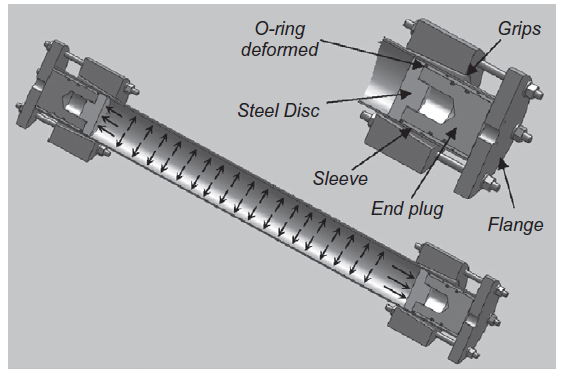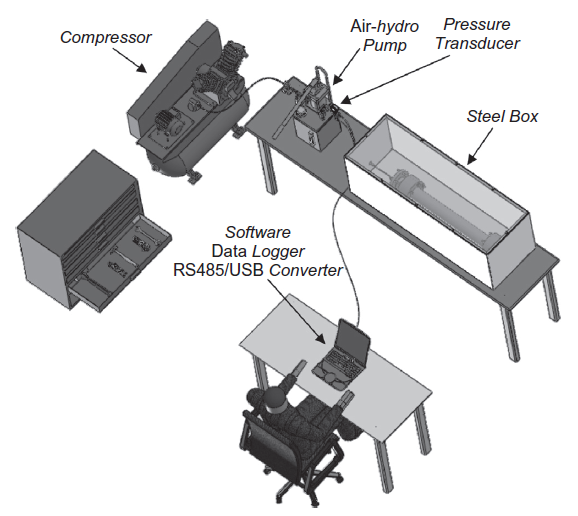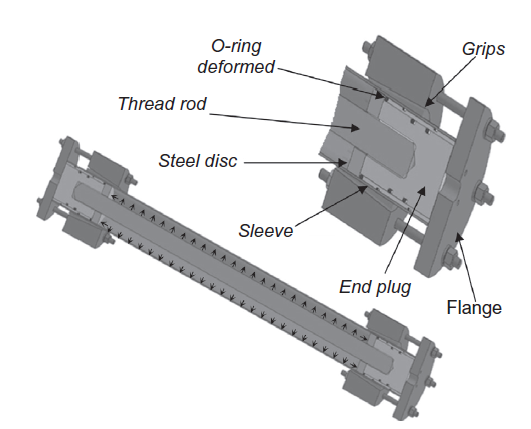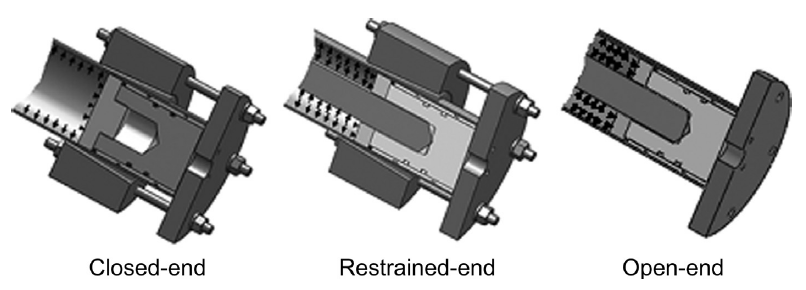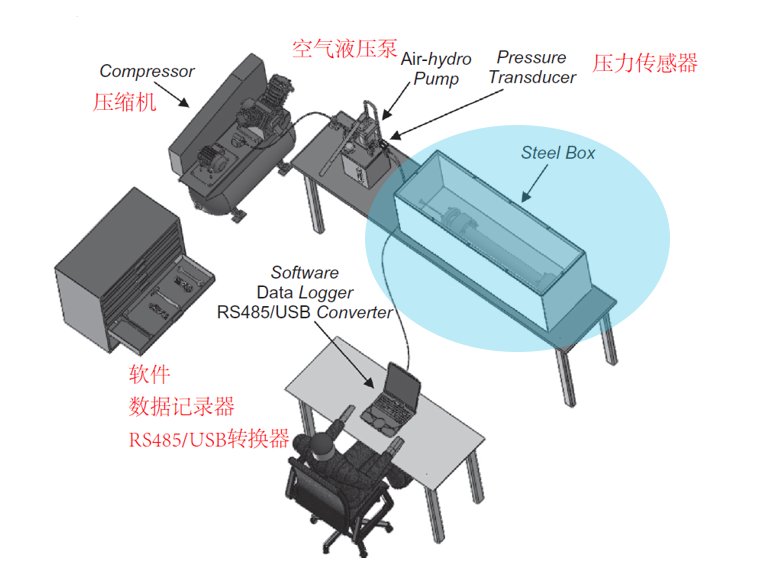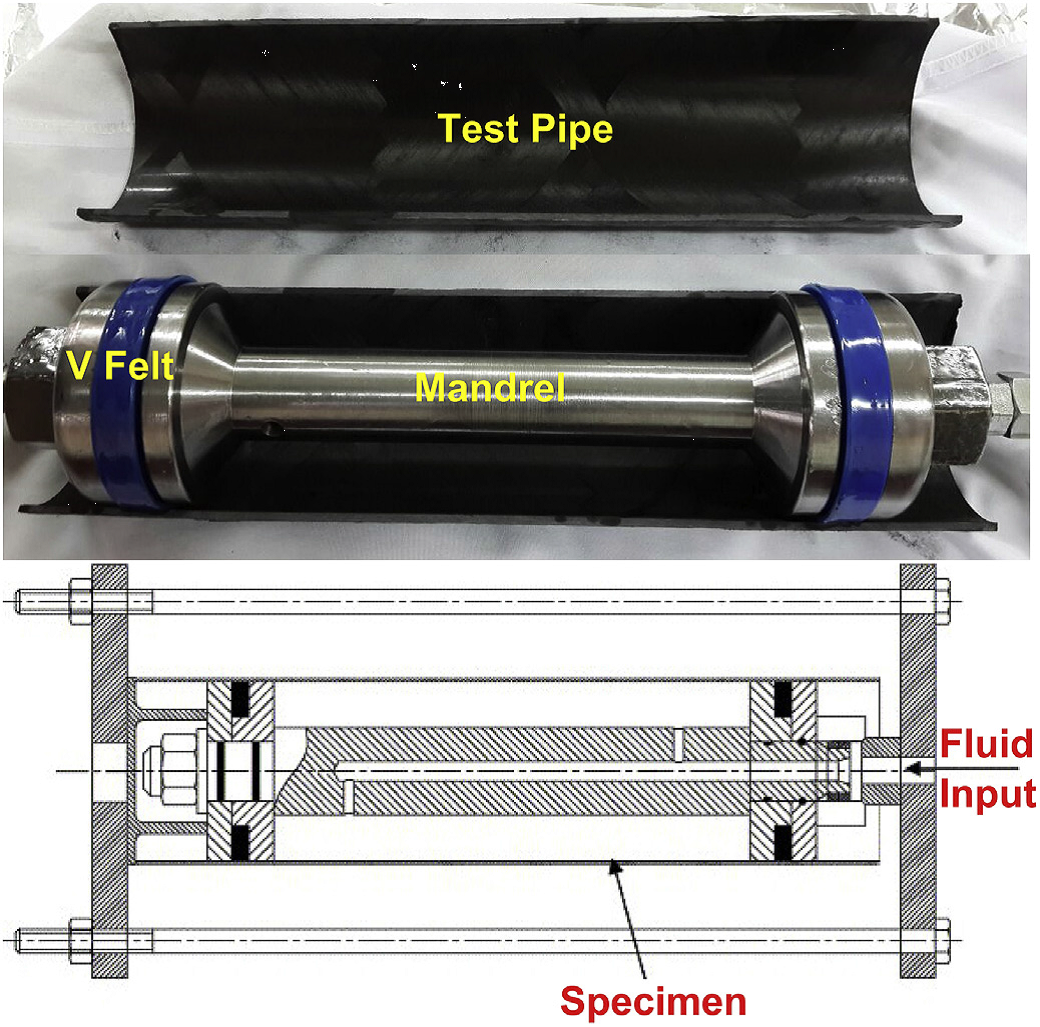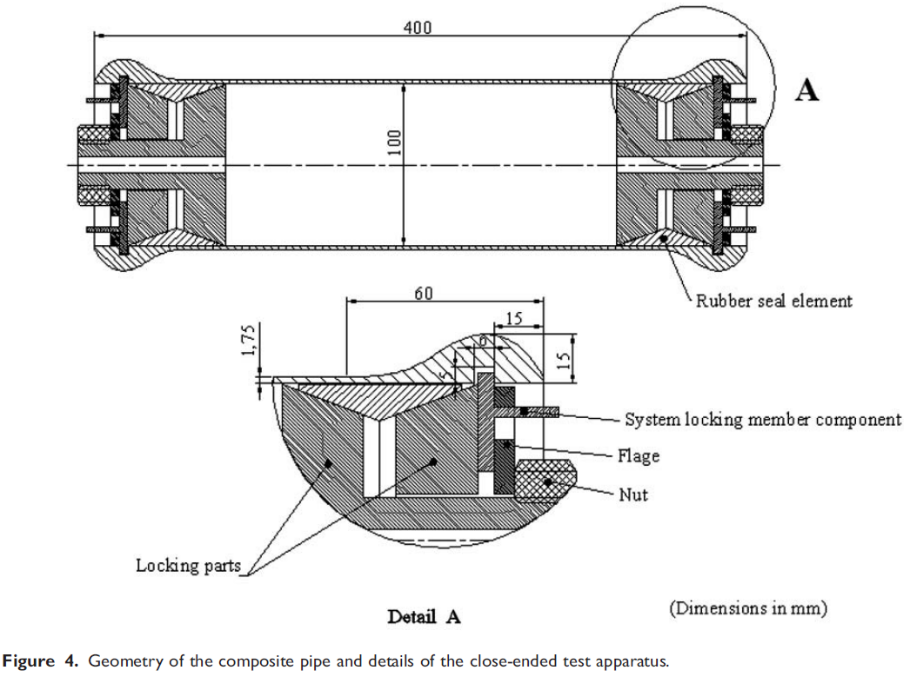纤维缠绕压力容器内压试验装置设计毕业论文
2020-04-15 17:35:53
摘 要
纤维缠绕压力容器凭借轻质、高强、安全以及功能集成性较好等优点,成为新型车载压力容器、超高压氢燃料以及医用、救生氧气管的理想结构。然而,压力容器特殊的结构形式以及复合材料的不可焊接性,使得纤维缠绕压力容器内压试验的难度大大提高,主要体现在端头密封压力等级高、密封可靠性等方面。本课题基于此背景,探索纤维缠绕压力容器端头密封机理及密封结构,建立纤维缠绕压力容器内压试验装置。但为简化设计及分析,本文主要以纤维缠绕复合管的内压试验装置为对象进行研究,并完成了以下工作:
(1)设计并加工完成了纤维缠绕复合管的内压试验装置。通过对试验装置的端部密封结构的分析,采用了类似约束端的密封设计,并对其主要密封部位如密封圈及沟槽进行了详细的设计阐述以及相关部位的强度校核计算。
(2)制定并完成了纤维缠绕复合管的内压试验。试验以复合管发生爆破并失效结束,爆破压力达到22.425MPa,复合管失效部位处的金属内衬与增强层均发生破坏,增强层的破坏形式为基体开裂以及纤维沿缠绕方向断裂。分析数据绘制了内压试验过程中压力与时间的变化曲线,总结发现设计的内压试验装置在密封效果上已初步达到要求。
(3)基于ABAQUS软件建立了在内压作用下的纤维缠绕复合管的有限元模型。通过软件计算得出的缠绕管失效压力为25MPa,失效模式为纤维和基体的拉伸失效,将其与试验结果比较得到相对误差为11%,较为吻合,从侧面验证了试验并进一步证明装置设计的可行性。
关键词:复合材料 纤维缠绕 压力容器 内压试验装置 有限元分析
Design of Internal Pressure Test Device for Filament Wound Pressure Vessel
Abstract
With the advantages of light weight, high strength, safety and good functional integration, filament wound pressure vessel has become an ideal structure for new on-board pressure vessel, ultra-high pressure hydrogen fuel and medical life-saving oxygen pipe. However, the special structure of the pressure vessel and the non-weldability of the composite material make the internal pressure test in the fiber-wound pressure vessel much more difficult, mainly in the high pressure level of end seal and its sealing reliability. Based on this background, the paper explores the end sealing mechanism and structure of the filament wound pressure vessel, and designs an internal pressure test device for it. But in order to simplify the design and analysis, this paper studies primarily on the internal pressure test device for the composite pipe. The works are as followed:
(1) The internal pressure test device for the filament wound composite pipe was designed and manufactured. Through the analysis of the end sealing structure of the test device, a design similar to the restraint end was adopted. Some important sealing parts such as sealing rings and grooves were described in detail, as well as the strength check of the relevant parts was calculated.
(2) The internal pressure test of the filament wound composite pipe was formulated and completed. In the test, the composite pipe was blasted and failed, which bursting pressure reached 22.425 MPa. The metal lining and the reinforcement layer at the failure site of the pipe were both damaged. The failure mode of the reinforcement layer was matrix cracking and fiber fracture along the winding direction. After the data being analyzed, the changing curve of pressure-time during the internal pressure test was drawn, which is found that the sealing requirement of the designed device has been met initially.
(3) Based on ABAQUS software, a finite element model of filament wound composite pipe under internal pressure was established. The failure pressure of the pipe calculated by the software is 25 MPa, and the failure mode is the tensile failure of the fiber and matrix. The relative error between the value obtained from the software and experimental results is 11% which is consistent with each other. The test is verified from the side and the feasibility of the design is further proved.
Keywords: Composite; Filament winding; Pressure vessel; Internal pressure test device; Finite element analysis
目 录
摘要 I
Abstract II
第一章 绪论 1
1.1 课题研究背景及意义 1
1.2 国内外研究现状 1
1.2.1 纤维缠绕复合材料概述 1
1.2.2 纤维缠绕压力容器内压试验 3
1.3 本文主要研究内容及研究方法 4
1.3.1 主要研究内容 4
1.3.2 研究方法 5
1.4 本章小结 5
第二章 内压试验装置的设计分析 6
2.1 设计指标 6
2.2 密封设计 7
2.3 内压试验装置设计方案 9
2.3.1 内压试验装置整体结构 9
2.3.2 O形橡胶密封圈及沟槽尺寸的设计 9
2.4 材料选择 11
2.5 内压试验装置的校核及分析 12
2.5.1 螺栓的强度校核 12
2.5.2 端盖的剪切强度校核 12
2.6 本章小结 14
第三章 缠绕管的制备及其内压试验研究 15
3.1 试验材料 15
3.1.1 内衬 15
3.1.2 树脂基体 16
3.1.3 增强纤维 17
3.2 纤维缠绕工艺 18
3.2.1 纤维铺层方案 18
3.2.2 制备工艺 20
3.2.3 制备流程 21
3.3 内压试验分析 22
3.3.1 内压试验方案 22
3.3.2 试验结果分析 23
3.4 本章小结 25
第四章 缠绕管内压试验的有限元分析 26
4.1 缠绕管有限元模型 26
4.1.1 几何模型及网格划分 26
4.1.2 载荷及边界条件的设置 27
4.1.3 材料特性及接触属性设置 28
4.2 计算结果 29
4.3 本章小结 31
第五章 结论与展望 32
5.1 结论 32
5.2 展望 33
第六章 经济性分析 34
参考文献 35
致谢 37
第一章 绪论
1.1 课题研究背景及意义
压力容器是一种具有特定使用场合、能承受一定内应力的设备,其使用场所常存在腐蚀介质、特殊温度或特殊压力等复杂条件,这就很大程度上增加了其危险性。目前国内压力容器制造大多采用钢材,主要为碳素钢、低合金钢及高合金钢,但钢材综合性能的局限性也限制了压力容器的设计制造[1]。随着材料科学的不断进步,越来越多的人们将目光投向了复合材料,而纤维缠绕复合材料又因其较之传统材料的强耐蚀性、高比强度、高弹性模量、轻质量、易加工等不可替代的优势,已在航空航天、化工、能源、冶金、医疗等领域获得广泛应用。一般而言,复合管道在使用过程中主要承受的是内压作用,即环向应力占主导地位,因此,为确保压力容器在使用时的安全可靠性,对于新制造或检修后的压力容器,使用超过操作压力的试验压力进行压力试验以检验容器的宏观强度、密封结构的严密性是至关重要的[2]。然而,纤维缠绕压力容器特殊结构形式以及不可焊接的复合材料,使得压力容器内压试验的难度大大提高,因而设计制备具有高密封性能的内压试验装置是急需解决的问题。
1.2 国内外研究现状
1.2.1 纤维缠绕复合材料概述
复合材料是指由两种或两种以上不同化学物理性质的材料组合而成的工程材料[3]。然而,复合材料并不是人类的发明,而是已经在自然界中存在已久,以竹子为例,它就是由诸多不同直径的管状纤维素分散于基体中从而形成的复合材料[4]。进入21世纪,由于科技水平的不断提高以及对新材料的迫切需求,新材料技术得到了进一步发展,而复合化也成了未来新型材料的重要发展方向。复合材料逐渐发展成能与金属材料、无机非金属材料和高分子材料并列的四大材料体系之一[5]。
纤维复合材料是上世纪研发的具有高强度、低重量的新型复合材料[6]。虽然原有的材料加工工艺已经达到了相当成熟的地步,但它却并不适合复合材料的加工,故复合材料的出现也随之带动着加工工艺的革新与进步。在众多复合材料成型技术之中,纤维缠绕法是最早开发且使用最为广泛的加工技术之一,同样也是目前生产复合材料的最重要的工艺[7]。纤维缠绕是把浸有树脂的纤维材料(如玻璃钢、碳纤维等)尽可能均匀地覆盖在芯模(决定产品形状的模具)上[8],常压下在室温或较高温度下固化成型的一种复合材料制造工艺[9]。与其他成型方法相比,使用缠绕工艺得到的复合材料制品具有纤维排列整齐、准确率高等特点,因此其比刚度和比强度均较高[10]。另外由于纤维的各向异性,仅通过改变其铺层角度和方式就可较大程度影响制品的性能,因此纤维缠绕法的设计较之其他更为灵活自由[11]。
以上是毕业论文大纲或资料介绍,该课题完整毕业论文、开题报告、任务书、程序设计、图纸设计等资料请添加微信获取,微信号:bysjorg。
相关图片展示:
